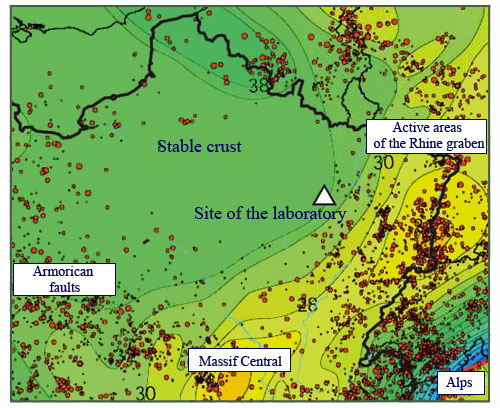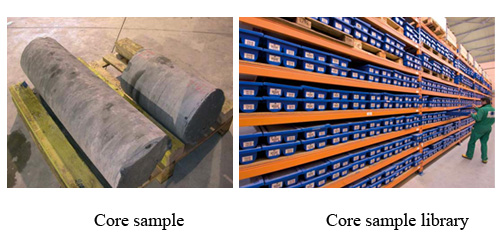Results on deep clay disposal
What we know about the disposal facility site
In its final report in 2006 the French National Assessment Board (CNE) said that it considered the most advanced research into nuclear waste management in France to be research into reversible disposal in deep geological formations. This is due in large part to the fact that both mining techniques and oil industry techniques can be used.
To recap on the conditions necessary for a geological formation to be able to accommodate high-level waste: the formation needs to be deep, capable of retaining the radioelements in the long term, and geologically stable. There must be little movement of water within the formation itself and adjacent formations. The permeability of the rock should be very low and the migration into the environment of radioelements dissolved in water, through diffusion, should be very slow. Finally, it should be possible to build structures in the rock and the rock should remove sufficient heat.

Low seismic risk
The Bure underground laboratory and the future CIGEO waste disposal facility, to be built nearby, are in an area in north-eastern France geologically very stable, as this earth tremor map shows. Seismic measurement campaigns, drilling of boreholes and testing of samples have provided further knowledge of the host formation and the formations surrounding it.
© ANDRA
The vast amount of knowledge obtained has shown that the Bure site appears to fulfil the conditions, to the extent that the decision in principle to build a waste disposal facility there was made in 2006 following CNE’s recommendations: ‘Disposal in a very even and uniform argillaceous rock without any faults through which water could flow, such as the Callovo-Oxfordian formation, can taken as the reference solution’.
There seems to be a good understanding of the geological environment. The layers are simple and even in shape. The geological environment is stable and there are no exploitable natural resources that suggest the possibility of human intrusion in the future.
The studies have confirmed the favourable properties of the clay formation. The permeability of clay is very low and it has a high containment capability. The formation is uniform over a large area, there are no faults, and it is suitable for mining excavations. Its characteristics are compatible with repository reversibility requirements.
The findings with regard to water movement are favourable. The limestone formations above and below the Callovo-Oxfordian argillites are also relatively impermeable and water movement is very slow. The outfalls are recognised.
Studies have been done on damage to the area caused by construction, by the operation of a waste disposal facility, and by the presence of foreign materials (cement, concrete and metal). The results suggest that the damaged area tends to become impermeable again through the creep and swelling of the argillites, which causes fractures gradually to close up. In the very long term, the properties of the area would tend to revert to those of the undisturbed argillite because the fractures close up through the effect of stresses returning to equilibrium.

Argillite core samples
From the shafts being excavated, scientists extracted samples of the rocks around the shaft walls, creating a ‘core sample library‘. They drew up a detailed geological survey of the entire height of the shaft wall. Geology was confirmed by the addition of data on the sediments and microstructures. In a rock such as clay, where diffusion is extremely slow, the ‘harvesting’ of interstitial water and the taking of geochemical measurements, including radioisotopes, provide crucial information about the rock’s history and prediction of its behaviour.
© ANDRA
The removal of the heat released by the high-level waste packages – their thermal impact – is what determines the spacing of the waste packages and therefore the size of the facility. Experiments carried out on samples have shown that the mineralogical transformation of the argillites is negligible as long as the initial temperatures are not too high. Over long disposal periods, this temperature drops rapidly.
However, more work still needs to be done before the research will be complete. If France took disposal in an argillaceous rock as the reference solution, the CNE said that it would have to ‘study this solution inside out’.
Other articles on the subject « Geological disposal »
Waste duration
Nuclear spent fuel and vitrified waste: what legacy? “Much of this nuclear waste will remai[...]
CIGEO project
CIGEO – Overview of a planned repository The efforts made by engineers to ensure that highl[...]
Clay medium
The Callovo-Oxfordian argilite The geological stratum or ‘host rock’ that will[...]
Bure underground laboratory
A research laboratory for a disposal facility site Before high-level radioactive waste is buried [...]
High-level waste repositories
Disposal of high-level waste packages The high-level waste packages requiring disposal will proba[...]
ILW-LL waste repositories
Filling an intermediate-level waste disposal cell Intermediate-level (ILW-LL) waste releases litt[...]
Waste disposal USA
Back to the drawing board after Yucca Mountain WIPP, the first deep geological repository to begi[...]
WIPP Project
The world’s first deep geological repository The United States is the first country in the [...]
Waste disposal Sweden
Sweden and Finland – Exemplary waste management Sweden probably features among the E[...]
Other countries
Shared challenges and similar solutions In most countries with nuclear industries, solutions for [...]